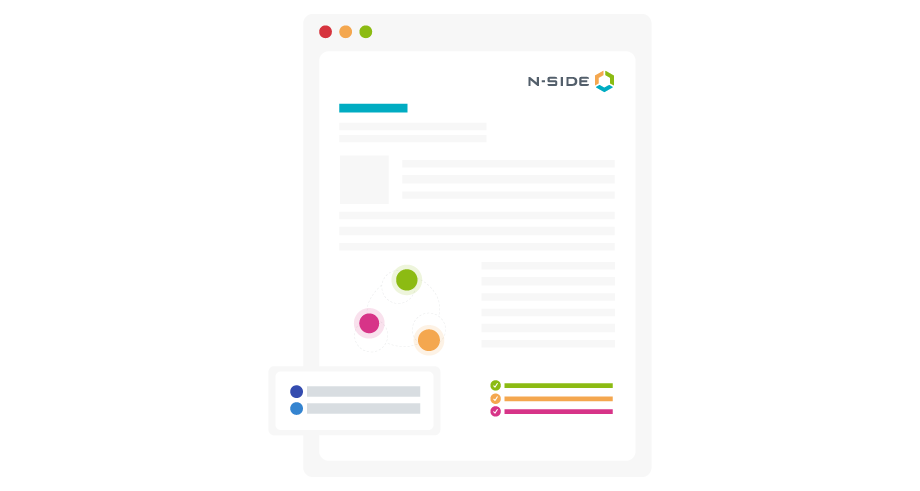Professional Services
Whether your challenge can be solved by our existing products or requires the development of new analytics solutions and market design approaches, our team is ready to help.
The UMEI - How a European standard is simplifying DSO interactions with local markets.


This article is part of a broader series linked with the EUniversal Project and how N-SIDE is helping 3 major DSOs to simplify communications.
As introduced in the first article of this four-article series, N-SIDE and many other actors are developing tools and launching initiatives around local flexibility markets for DSOs. While all these intentions are valuable in building a better future, many of these projects are creating an unstructured IT setup that is not desirable.
It is on this issue that close to 20 European partners from the industry, system operators, european associations, research centres and universities are working in EUniversal to build the Universal Market Enabling Interface (UMEI).
To understand the UMEI and how it can help actors involved in local flexibility, let’s first describe how a local flexibility market works. If you are already familiar with the concept, you can directly jump to the next section.
Back to basics: how does a local flexibility market work?
At the base of local flexibility lie households and industries that own assets that can be used for flexibility; like batteries, electric vehicles and heat pumps that are capable of quickly responding to real-time conditions. Eligible assets willing to offer their flexibility services are gathered by aggregators, which can coordinate multiple small assets.
Aggregators allow to pool larger amounts of flexibility together as a single offer, which is more attractive for system operators. Furthermore, it limits the dedication required from the asset owner thanks to the delegation of the work to an aggregator.
Examples of aggregators in Europe are Centrica, Eneco CrowdNett, Emsys and Next Kraftwerke.
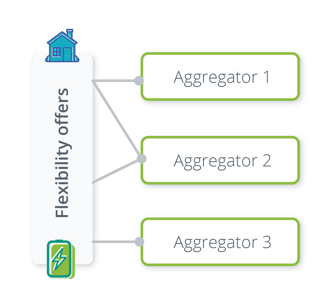
Aggregators then propose the flexibility of their customers (i.e. the households or companies) on Flexibility market platforms.

Examples of Market Platforms in Europe are LocalFlex (EPEX - N-SIDE partnership), NODESmarket and Piclo Flex.
Similar to any market place in any industry, the key role of these market platforms is to centralise the needs and offers for actors willing to buy or sell their assets.
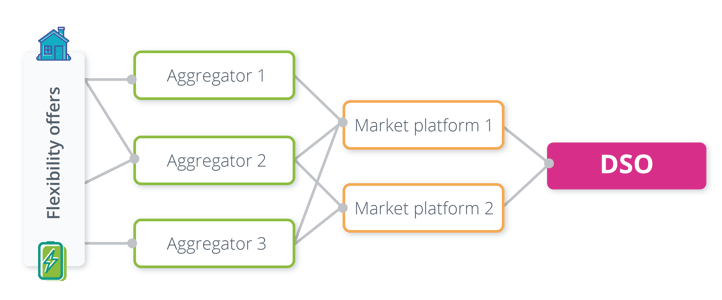
In the case of our local market platforms, the 'assets' are flexibility needs (coming from the DSO) that are traded with the flexibility offered by the aggregators. This can be done in a continuous way (i.e. from as basic as how trades are done on ebay or Facebook Marketplace, to the automatic matching of bids with the exact same prices and quantities as it is done for stock exchanges) or in an close-gate fashion through an auction and an optimised market clearing algorithm (like the N-SIDE Power Matching Algorithm) to maximise social welfare.
DSOs and aggregators need to communicate with market platforms to express their offers and needs. Over the last year, advances in the field were driven by each market platform provider developing its custom communication protocol to be used by both aggregators and DSOs. Given the perspective that these local markets would become widespread and that each market platform is proposing its own standard, there is a growing risk of moving toward an inefficient system (more details in the first article) which can be avoided today.
This is where the Universal Market Enabling Interface comes into action.
The UMEI or Universal Market Enabling Interface is a standard interface that defines how all parties; aggregators, market platforms and DSOs can communicate in a simple and efficient way. It has been crafted together by the EUniversal project consortium, especially E-REDES, N-SIDE and NODES.
Visually-speaking, taking back our previous diagram, the UMEI can be seen as a support for all communications required around the market platforms.
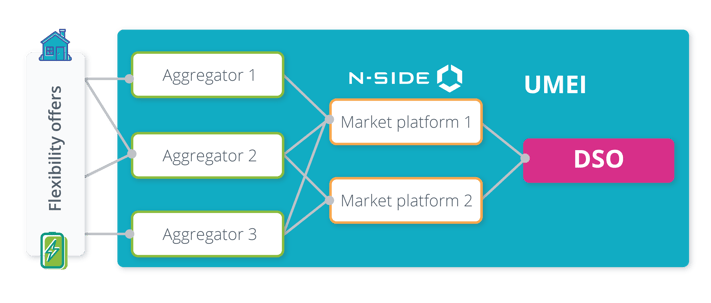
The UMEI enables an agnostic, adaptable, and modular combination of different APIs and allows for the exchange of information for the purpose of mobilisation and activation of flexibility. Simply stated, it can be seen as "a common language for energy flexibility".
Since it is an open-source standard, the already existing set of APIs is publicly available (on Github (https://github.com/euniversal/umei-api-specification) and on the project website (https://euniversal.eu/the-umei/) ), allowing any stakeholder to adopt the API or to extend it to support new services while complying with the UMEI interface specification.
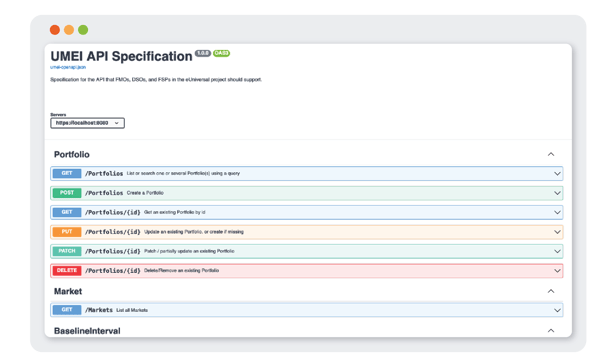
The communication between the parties is done in multiple steps. These steps define the structure of the UMEI in four phases:
- Prequalification phase (not covered by this version of the UMEI): set up basic master data like portfolios and grid nodes.
- Pre-trading phase: define baselines and flexibility zones and extract market and portfolio information, for use in the next phase.
- Trading phase: post and read orders and trades
- Post-trading phase: provide metre readings for assets used in trades.

The UMEI is used as a standard by the different partners of the EUniversal project to develop market-driven flexibility services and network operation tools. This is set up by three demonstrators throughout Europe.
For example, the same API can be used in Germany, Poland and Portugal to address DSO flexibility needs regarding their congestion management and voltage control the day prior to real-time.
In the next two episodes, we will see more precisely how N-SIDE and its partners rely on the UMEI to run market platforms providing flexibility to German and Portuguese DSOs. Alongside, we will present two other innovations beyond the UMEI that can help DSOs benefit from efficient markets without having to share sensitive grid data.
This project has received funding from the European Union’s Horizon 2020 research and innovation programme under grant agreement No 864334.
This article reflects only the N-SIDE view. The European Commission Innovation and Networks Executive Agency is not responsible for any use that may be made of the information it contains.
Co-Author
Pierre Crucifix is an Engineer and Economist active in market-oriented activities at N-SIDE. He has contributed to some Euphemia R&D achievements and to the deployment of our Power Matching Algorithm in India. He has also worked for system operators by designing and delivering solutions for local and balancing markets. Pierre is now the Product Manager of the N-SIDE Power Matching Algorithm, shaping how our market clearing offer can evolve to allow even more end-consumers worldwide to get access to cheaper and cleaner electricity.
The Euniversal Series
The new local consumption and production patterns from residential consumers pose significant challenges for DSOs in managing their power grid. To avoid costly reinforcements in order to cope with very local issues, relying on residential flexibility is envisioned through market approaches.
The EUniversal project proposes to rely on a common standard at European level to ease market interactions. Adopting it will prevent an unstructured IT setup that leads to vendor lock-in, hindering flexibility and market competition before it is too late.
Through this series, learn more about the problem, how the solution was designed and how it is used by major DSOs in Europe.
- How N-SIDE helps DSOs take the most of various sources of flexibility simultaneously: the EUniversal project
- The UMEI - How a European standard is simplifying DSO interactions with local markets.
- How can a DSO manage simultaneously grid planning, scheduled maintenance and congestion management via market solutions?
- How to reconcile the sensitivity of system operator data with efficient grid-aware markets?
This project has received funding from the European Union’s Horizon 2020 research and innovation program under grant agreement No 864334.
This article reflects only the N-SIDE view. The European Commission Innovation and Networks Executive Agency is not responsible for any use that may be made of the information it contains.





Other content like this one...
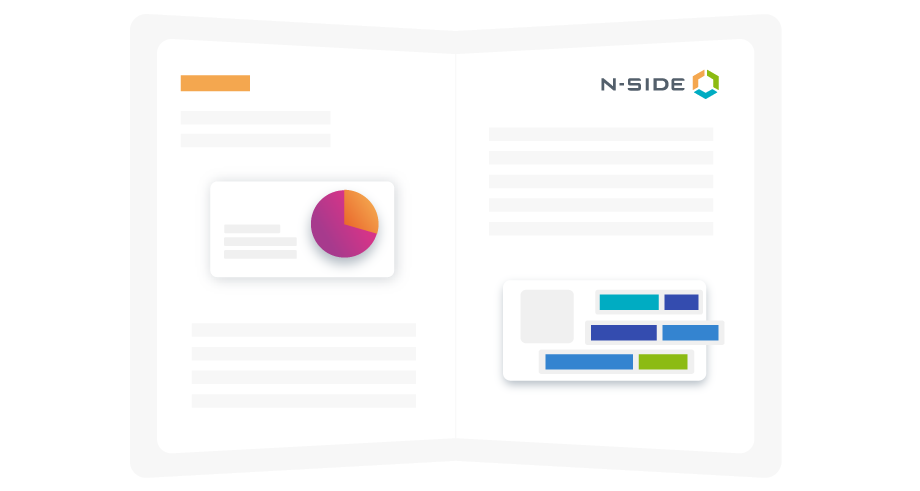
article
How N-SIDE helps DSOs take the most of various sources of flexibility simultaneously: the EUniversal Project

Article
Power Market Auctions 101
Understand the basics of power market auctions: The economic principles useful for understanding power markets and auctions, how European power markets are organized, what is the welfare optimization and why it is important, and what is meant by crossing the supply and demand. read more